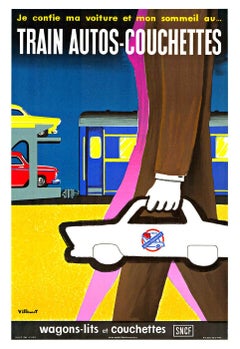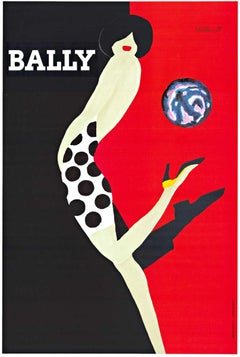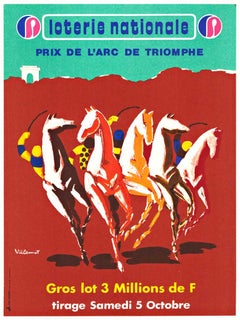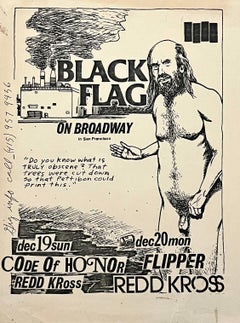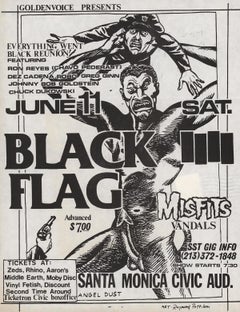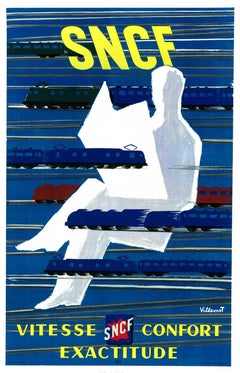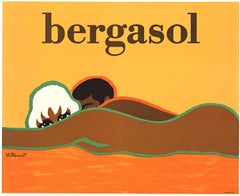Bernard Villemot Figurative Prints
French, 1911-1989
Villemot, one of the leading graphic designers in France during the post-war period, is regarded as one of France's most talented twentieth-century poster artists. He was the subject of retrospective exhibitions at the Musee des Arts Decoratifs and the Bibliotheque Nationale in Paris between 1980 and 2000. Belonging to the movement that moved towards an international graphic style after the Bauhaus and de Stijl, Villemot's advertising clients included Air France, Perrier, Orangina, and Bergasol. His work is characterized by vivid colors, thin outlines, and abstract and organic forms.to
1
2
1
Overall Width
to
Overall Height
to
3
1
73
859
382
373
308
4
1
2
1
4
3
3
1
1
1
1
1
1
1
1
1
1
2
2
4
Artist: Bernard Villemot
Original Bergasol vintage poster Villemot Sunscreen
By Bernard Villemot
Located in Spokane, WA
Original vintage poster: Bergasol. Artist: Bernard Villemot Professional mounted on acid-free archival linen. Ready to frame. In very fine condition.
The Bergasol poster i...
Category
1970s Pop Art Bernard Villemot Figurative Prints
Materials
Offset
Original Train Autos-Couchettes vintage French poster 1964 linen backed
By Bernard Villemot
Located in Spokane, WA
Original 1964 Bernard Villemot Poster — SNCF “I Entrust My Car and My Sleep to …” — Linen Backed Vintage Travel Advertising Art. Fine condition, Grade A. Excellent colors and rea...
Category
1960s American Modern Bernard Villemot Figurative Prints
Materials
Lithograph
Original Bally-Chaussures-Globe vintage fashion poster
By Bernard Villemot
Located in Spokane, WA
Original poster: BALLY, a.k.a. Bally Kick and Bally Globe.
Artist: Bernard Villemot. Ready to frame. Note that this is the small format version of the poster. Museum linen backed. A poster that is a combination of both art and advertisement. This is one of the last posters that Villemot created. Grade A Condition.
The image shows a woman kicking up her heel, while her shadow is that of a man's leg and shoe. The globe in the background shows that Bally is a worldwide company.
Add a touch of elegance and nostalgia to your space with this stunning original Bally vintage poster...
Category
1980s Modern Bernard Villemot Figurative Prints
Materials
Offset
Original Loterie nationale L'arc de Triomphe vintage poster
By Bernard Villemot
Located in Spokane, WA
Original Loterie Nationale, Prix de L’Arc de Triomphe vintage French poster. Artist: Bernard Villemot. Archival linen backed in excellent, mint condition, ready to frame.
The image features five modernism-style jockeys on racehorses for this 1974 poster...
Category
1970s American Modern Bernard Villemot Figurative Prints
Materials
Lithograph
Related Items
Raymond Pettibon Black Flag punk flyer (Raymond Pettibon Punk)
By Raymond Pettibon
Located in NEW YORK, NY
Raymond Pettibon illustrated Black Flag flyer published on the occasion of: Black Flag on Broadway / Dec. 19 1982 / Dec. 20 1982 with Code of Honor, Redd Kross, Nig-Heist, & Flipper...
Category
1980s Pop Art Bernard Villemot Figurative Prints
Materials
Offset
$1,000
H 11 in W 8.5 in
Raymond Pettibon Black Flag 1983 postmarked (Raymond Pettibon prints)
By Raymond Pettibon
Located in NEW YORK, NY
Raymond Pettibon: Rare early Black Flag punk flyer:
Black Flag Santa Monica Civic Auditorium, Jun 11, 1983. Santa Monica, CA. Flyer / handbill for gig by Black Flag, Misfits, Vandals featuring artwork by Pettibon. Post-marked 1983 on verso; rare as such given the SST stamp on verso (Black Flag's record label).
Offset Print; 8.5 x 11 inches.
Features Pettibon printed signure on the lower right.
Condition: Minor signs of handling and fading or yellowing; fold-lines and staple marks to upper & lower center (these were originally stapled together and mailed); in otherwise very good overall condition given age & medium.
Post-marked 1983 and hand addressed on verso. Rare.
Flea, the Red Hot Chili Peppers bassist once said of Pettibon's Black Flag illustrations and iconic logo: "Before I knew what Black Flag was I remember walking around Hollywood and seeing Raymond's flyers and being like, 'What the fuck is that?'… Those flyers made me feel like something is going on and it's romantic and it's mysterious and it's heavy and I don't know what it is but I wanna know."
About Raymond Pettibon (Americanb. 1957)
Raymond Pettibon is a contemporary American artist known for his stylized ink drawings combining images and text. His inventive narratives blend historical content with consumer culture to yield incisive critiques of contemporary society. “I was making my work as transparent as possible, without equivocations, without calling attention to itself, without apology,” he explained. “There's a lot of conventions in the art world that are not to be transgressed, but my economy of means doesn't abide by those strictures.” Born Raymond Ginn on June 16, 1957 in Tucson, AZ, the artist is self-taught, but cites drawings by William Blake, Edward Hopper, Francisco Goya, and John Sloan as instructive to his practice. Deriving inspiration from comics, cartoons, and other pop culture iconography, Pettibon began designing album covers and ephemera for his brother’s band Black Flag in the mid-1970s. He went on to produce cover art for Sonic Youth, the Minutemen...
Category
1980s Pop Art Bernard Villemot Figurative Prints
Materials
Offset, Lithograph
Raymond Pettibon Black Flag 1982 postmarked (Raymond Pettibon punk flyer)
By Raymond Pettibon
Located in NEW YORK, NY
Raymond Pettibon Black Flag:
1982 Raymond Pettibon illustrated Black Flag punk flyer published on the occasion of: Black Flag, Saccharine Trust, The Minutemen...
Category
1980s Pop Art Bernard Villemot Figurative Prints
Materials
Offset, Lithograph
Keith Haring Help the Homeless 1989 (Keith Haring 1989 announcement)
By Keith Haring
Located in NEW YORK, NY
Keith Haring 1989:
Keith Haring illustrated announcement card, NY, 1989. Published on the occasion of a 1989 fundraiser to help the homeless.
Off-set printed, 1989.
Measures: 5 x 7...
Category
1980s Pop Art Bernard Villemot Figurative Prints
Materials
Lithograph, Offset
Keith Haring Into 84 poster (vintage Keith Haring)
By Keith Haring
Located in NEW YORK, NY
Keith Haring Into 84 exhibition poster:
Vintage original 1980's poster designed by Keith Haring for his well-documented exhibition, 'Keith Haring: Into 84' at...
Category
1980s Pop Art Bernard Villemot Figurative Prints
Materials
Lithograph, Offset
Adolf Dehn, Lake Tarryall, 1941 mid-century lithograph of Colorado mountain lake
By Adolf Dehn
Located in New York, NY
Lake Tarryall, a 1941 lithograph by Adolf Dehn (1895-1968) was made while he was teaching in Colorado. A native of Waterville, Minnesota, Dehn attended the Minneapolis School of Art ...
Category
1940s American Modern Bernard Villemot Figurative Prints
Materials
Lithograph
$750
H 13.75 in W 17.25 in
Keith Haring Help the Homeless 1985 (Keith Haring 1985 announcement)
By Keith Haring
Located in NEW YORK, NY
Keith Haring 1985:
Keith Haring off-set illustrated announcement card, NY, 1985: "NY for NY, Help The Homeless" at The Roxy, West 18th St., NYC.
Off-set printed, 1985 (folds open in...
Category
1980s Pop Art Bernard Villemot Figurative Prints
Materials
Offset, Lithograph
Untitled from Doctors of the World Portfolio, hand signed & numbered Pop realism
By Chuck Close
Located in New York, NY
Chuck Close
Untitled Daguerreotypes, 2001
Two (2) pigmented digital output iris prints from daguerroeotype printed in a single sheet of wove paper
22 × 29 1/4 inches
Signed in pencil...
Category
Early 2000s Pop Art Bernard Villemot Figurative Prints
Materials
Lithograph, Pigment, Pencil
Norman Rockwell Original Lithograph Ice Skating Hand Signed Americana
By Norman Rockwell
Located in Surfside, FL
Norman Rockwell (1894-1978)
Ice Skating, from Grandpa and Me Suite
Offset lithograph print, hand signed in pencil, numbered AP E 9/10
27 x 23 in. (sight), 34.75 x 30 in. (frame).
...
Category
1970s American Realist Bernard Villemot Figurative Prints
Materials
Lithograph, Offset
Theresa Russell "Nude" print (Hand signed, inscribed and dated by David Hockney)
By David Hockney
Located in New York, NY
David Hockney
XVI RIP ARLES (Hand signed, inscribed and dated by David Hockney), 1985
Offset lithograph poster
Hand signed and inscribed with dateline London, 1985 by David Hockney o...
Category
1980s Pop Art Bernard Villemot Figurative Prints
Materials
Lithograph, Offset
$5,500
H 42.5 in W 28.5 in
Interview Magazine cover (hand signed by Andy Warhol) Framed Steve Rubell Estate
By Andy Warhol
Located in New York, NY
Andy Warhol
Interview Magazine (hand signed by Andy Warhol), 1985
Offset lithograph (hand signed by Andy Warhol)
Signed in brown marker
Frame included: Frame included: framed in a h...
Category
1980s Pop Art Bernard Villemot Figurative Prints
Materials
Lithograph, Offset
$3,500
H 20.75 in W 17.25 in D 1 in
Postcard of Phong Bui's portrait of Jasper Johns, hand signed by Jasper Johns
By Jasper Johns
Located in New York, NY
Jasper Johns and Phong Bui
Offset lithograph card of portrait of Jasper Johns by Phong Bui (hand signed and dated by Jasper Johns), 2008
Card depicting a portrait of Jasper Johns by ...
Category
Early 2000s Realist Bernard Villemot Figurative Prints
Materials
Ink, Postcard, Lithograph, Offset
Previously Available Items
Original SNCF Vitesse Confort Exactitude vintage French railroad poster, 1951
By Bernard Villemot
Located in Spokane, WA
Original 1951 SNCF “Vitesse Confort Exactitude” poster — Linen-backed, Grade A, by Bernard Villemot.
Discover a rare and striking piece of French railway history: this original, 19...
Category
1950s Art Deco Bernard Villemot Figurative Prints
Materials
Lithograph
H 38.5 in W 24.5 in D 0.3 in
Original Bergasol vintage poster Villemot Sunscreen
By Bernard Villemot
Located in Spokane, WA
Original vintage poster: Bergasol. Artist: Bernard Villemot Professional mounted on acid-free archival linen. Ready to frame. In very fine condition.
The Bergasol poster i...
Category
1970s Pop Art Bernard Villemot Figurative Prints
Materials
Offset
H 33.75 in W 27.25 in D 0.05 in
Original Bergasol vintage poster Villemot Sunscreen
By Bernard Villemot
Located in Spokane, WA
Original vintage poster: Bergasol. Artist: Bernard Villemot Professional mounted on acid-free archival linen. Ready to frame. In very fine condition.
The Bergasol poster i...
Category
1970s Pop Art Bernard Villemot Figurative Prints
Materials
Offset
H 33.75 in W 27.25 in D 0.05 in
Bernard Villemot for Bally
By Bernard Villemot
Located in Saint Ouen, FR
Bernard Villemot for Bally
Lithography
1982
42,5x64,5cm
290€
Category
1980s Bernard Villemot Figurative Prints
Materials
Paper
Original Espana "Spain" vintage Villemot travel poster
By Bernard Villemot
Located in Spokane, WA
Original untrimmed Spain, Espagna (España) authentic Bernard Villemot vintage European travel poster. Size: 24.5" x 39". Excellent condition, archival linen backed and ready to frame. This mid century modern antique poster has a flair of art deco design. The Dancers.
The image features flamingo...
Category
1950s Art Deco Bernard Villemot Figurative Prints
Materials
Lithograph
H 39 in W 24.5 in D 0.07 in
Bernard Villemot figurative prints for sale on 1stDibs.
Find a wide variety of authentic Bernard Villemot figurative prints available for sale on 1stDibs. You can also browse by medium to find art by Bernard Villemot in offset print, paper and more. Much of the original work by this artist or collective was created during the 20th century and is mostly associated with the Pop Art style. Not every interior allows for large Bernard Villemot figurative prints, so small editions measuring 17 inches across are available. Customers who are interested in this artist might also find the work of Bob Pardo, John Grillo, and John Kacere. Bernard Villemot figurative prints prices can differ depending upon medium, time period and other attributes. On 1stDibs, the price for these items starts at $316 and tops out at $498, while the average work can sell for $407.

